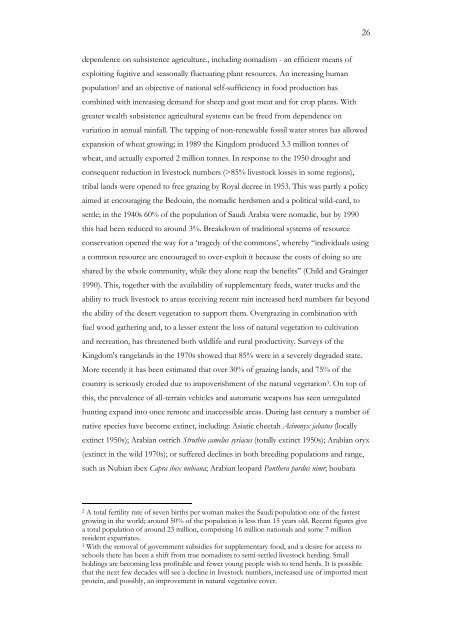The Unfenced Desert Towards a strategy for eco ... - Nwrc.gov.sa
The Unfenced Desert Towards a strategy for eco ... - Nwrc.gov.sa
The Unfenced Desert Towards a strategy for eco ... - Nwrc.gov.sa
You also want an ePaper? Increase the reach of your titles
YUMPU automatically turns print PDFs into web optimized ePapers that Google loves.
dependence on subsistence agriculture., including nomadism - an efficient means of<br />
exploiting fugitive and seasonally fluctuating plant resources. An increasing human<br />
population2 and an objective of national self-sufficiency in food production has<br />
combined with increasing demand <strong>for</strong> sheep and goat meat and <strong>for</strong> crop plants. With<br />
greater wealth subsistence agricultural systems can be freed from dependence on<br />
variation in annual rainfall. <strong>The</strong> tapping of non-renewable fossil water stores has allowed<br />
expansion of wheat growing; in 1989 the Kingdom produced 3.3 million tonnes of<br />
wheat, and actually exported 2 million tonnes. In response to the 1950 drought and<br />
consequent reduction in livestock numbers (>85% livestock losses in some regions),<br />
tribal lands were opened to free grazing by Royal decree in 1953. This was partly a policy<br />
aimed at encouraging the Bedouin, the nomadic herdsmen and a political wild-card, to<br />
settle; in the 1940s 60% of the population of Saudi Arabia were nomadic, but by 1990<br />
this had been reduced to around 3%. Breakdown of traditional systems of resource<br />
conservation opened the way <strong>for</strong> a ‘tragedy of the commons’, whereby “individuals using<br />
a common resource are encouraged to over-exploit it because the costs of doing so are<br />
shared by the whole community, while they alone reap the benefits” (Child and Grainger<br />
1990). This, together with the availability of supplementary feeds, water trucks and the<br />
ability to truck livestock to areas receiving recent rain increased herd numbers far beyond<br />
the ability of the desert vegetation to support them. Overgrazing in combination with<br />
fuel wood gathering and, to a lesser extent the loss of natural vegetation to cultivation<br />
and recreation, has threatened both wildlife and rural productivity. Surveys of the<br />
Kingdom's rangelands in the 1970s showed that 85% were in a severely degraded state.<br />
More recently it has been estimated that over 30% of grazing lands, and 75% of the<br />
country is seriously eroded due to impoverishment of the natural vegetation3. On top of<br />
this, the prevalence of all-terrain vehicles and automatic weapons has seen unregulated<br />
hunting expand into once remote and inaccessible areas. During last century a number of<br />
native species have b<strong>eco</strong>me extinct, including: Asiatic cheetah Acinonyx jabatus (locally<br />
extinct 1950s); Arabian ostrich Struthio camelus syriacus (totally extinct 1950s); Arabian oryx<br />
(extinct in the wild 1970s); or suffered declines in both breeding populations and range,<br />
such as Nubian ibex Capra ibex nubiana; Arabian leopard Panthera pardus nimr; houbara<br />
2 A total fertility rate of seven births per woman makes the Saudi population one of the fastest<br />
growing in the world; around 50% of the population is less than 15 years old. Recent figures give<br />
a total population of around 23 million, comprising 16 million nationals and some 7 million<br />
resident expatriates.<br />
3 With the removal of <strong>gov</strong>ernment subsidies <strong>for</strong> supplementary food, and a desire <strong>for</strong> access to<br />
schools there has been a shift from true nomadism to semi-settled livestock herding. Small<br />
holdings are b<strong>eco</strong>ming less profitable and fewer young people wish to tend herds. It is possible<br />
that the next few decades will see a decline in livestock numbers, increased use of imported meat<br />
protein, and possibly, an improvement in natural vegetative cover.<br />
26

















